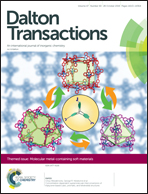An in situ spectroelectrochemical study on the orientation changes of an [FeiiiLN2O3] metallosurfactant deposited as LB Films on gold electrode surfaces†
Abstract
In this paper we analyze the changes in molecular orientation triggered by electrochemical reduction of an iron-containing surfactant in Langmuir–Blodgett films deposited onto gold electrodes. The metallosurfactant [FeIII(LN2O3)] (1) is an established molecular rectifier capable of unidirectional electron transfer between two electrodes. A gradual decrease in the activity is observed in sequential current vs. potential curves upon repeated cycles. Here we evaluate the redox response associated with the reduction of the FeIII/FeII couple in a single monolayer, as well as in a 5-layer LB film of 1. We use polarization modulation infrared reflection absorption spectroscopy (PM IRRAS) to follow structural and orientation changes associated with such applied potential scans. We observe that the reduction of the Fe center becomes increasingly irreversible because an Fe–Ophenolate bond is cleaved. This transformation is accompanied by an almost vertical change in the orientation of metallosurfactant molecules in LB films.
![Graphical abstract: An in situ spectroelectrochemical study on the orientation changes of an [FeiiiLN2O3] metallosurfactant deposited as LB Films on gold electrode surfaces](/en/Image/Get?imageInfo.ImageType=GA&imageInfo.ImageIdentifier.ManuscriptID=C8DT00333E&imageInfo.ImageIdentifier.Year=2018)
- This article is part of the themed collection: Molecular metal-containing soft materials


 Please wait while we load your content...
Please wait while we load your content...
